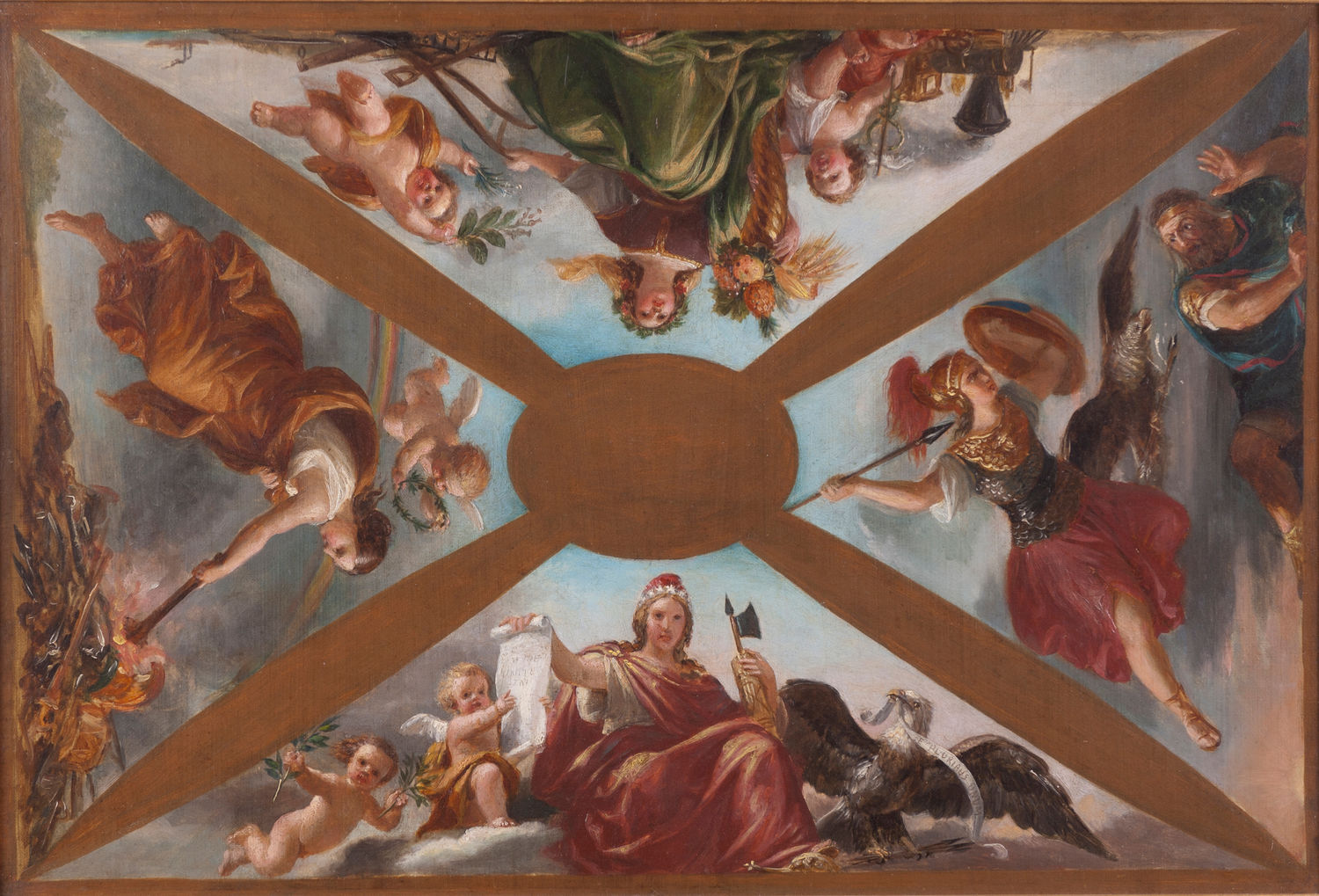
| Title | Sketch, Liberty, Peace, Plenty, War |
| Artist/Maker | Constantino Brumidi ( 1805 - 1880 ) |
| Date | 1858 ca. |
| Medium | Oil on canvas |
| Dimensions | Canvas: h. 16.25 x w. 24 in. (h. 41.275 x w. 60.96 cm)
Framed: h. 20.75 x w. 28.5 in. (h. 52.705 x w. 72.39 cm) |
| Credit Line | U.S. Senate Collection |
| Accession Number | 33.00026.000 |
Constantino Brumidi painted this oil sketch as a preparatory study for a ceiling fresco in the Senate Reception Room of the U.S. Capitol. The sketch is scaled to the Reception Room's vaulted architecture, and Brumidi depicts the allegorical figures of Liberty, Peace, Plenty, and War in the sketch's four quadrants.
Liberty dons a Phrygian cap and bears a fasces, an ancient Roman symbol of power and executive authority. Peace, whose attributes are a rainbow and olive wreath, touches her torch flame to a heap of weaponry. Plenty, who flourishes in times of peace, is flanked by symbols of a prosperous society: a locomotive, a steam boat, a plow, and a cornucopia overflowing with produce. War is portrayed by Minerva, the Roman goddess of wisdom and battle. War has vanquished her foe with a forcefully raised spear overhead and an American eagle by her side.
Between 1857 and 1860, Brumidi executed several murals in important rooms and public spaces in the Capitol. With Montgomery C. Meigs, the supervising engineer of the Capitol extension, Brumidi planned many additional murals. By 1859, Brumidi had designed most of the scenes he would paint at the Capitol over the next 25 years, including this proposal for the Senate Reception Room's north ceiling. Brumidi completed the preparatory study around 1858 but was not hired to execute the fresco until more than a decade later, in 1869.
At age 13, Constantino Brumidi entered Rome's prestigious Accademia di San Luca and spent 14 years studying drawing, painting, and sculpture. He earned important commissions and awards during his career in Italy in the 1830s and 1840s. When Brumidi immigrated to America in 1852, his rigorous academic training and professional experience gave him a distinct advantage: Brumidi was one of the few artists in the United States who was skilled at designing murals for large, complex spaces and who was proficient at painting in fresco, a challenging but traditional medium that was desired for the murals at the U.S. Capitol.
In keeping with the practices of his academic training, Brumidi often prepared meticulous, detailed sketches to scale in pencil as one of the preliminary steps to creating a mural. Brumidi would then work up preparatory studies, typically in oil on canvas, of the proposed scenes. The preparatory studies would be submitted for review to officials in charge of the decoration of the Capitol.
Once the proposed mural in a preparatory study was approved, Brumidi would enlarge the scene from the study to a full scale rendering on oversize paper, traditionally called a cartoon. The outlines of the images could then be transferred from the cartoon onto the wall or ceiling. Brumidi used the details worked out in the studies–such as coloring or shading–as his guide when executing a mural. Many of the preparatory studies for Brumidi's work in the Senate wing of the Capitol are in the Senate collection.